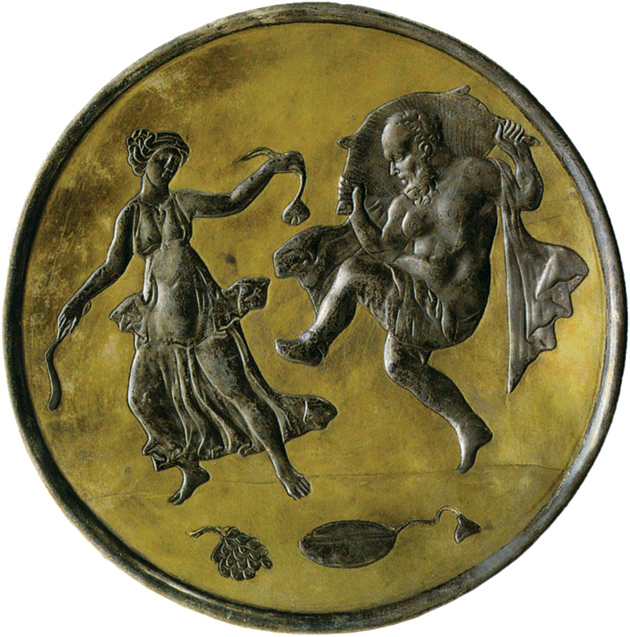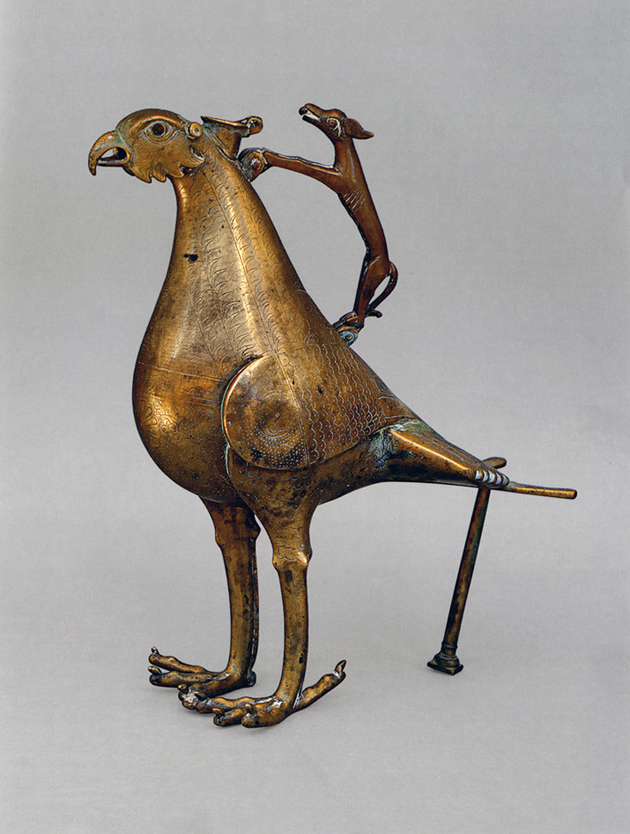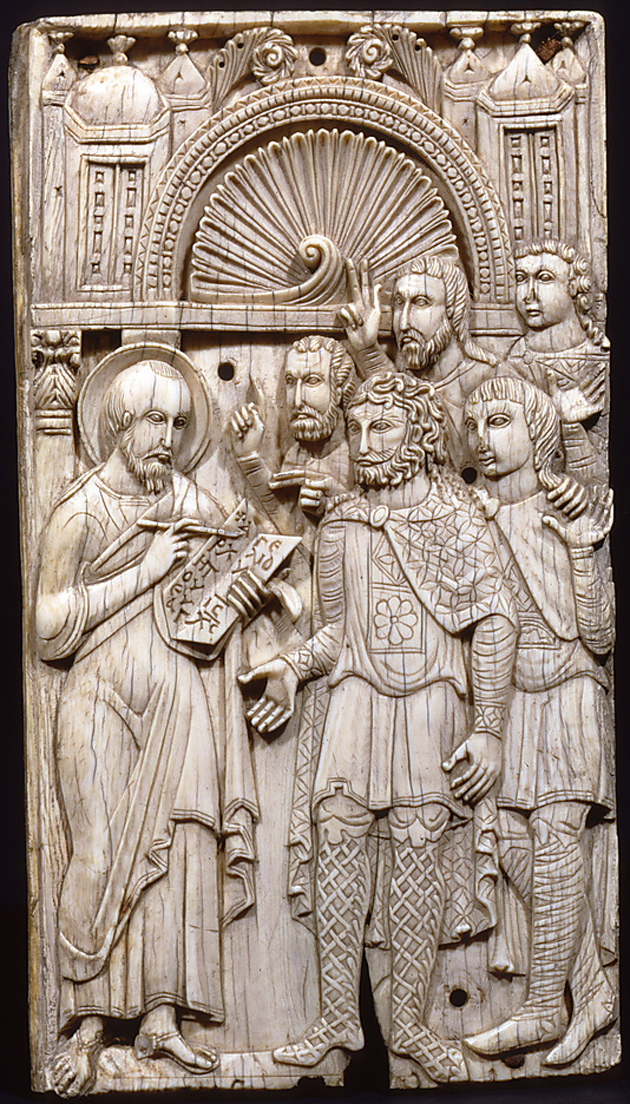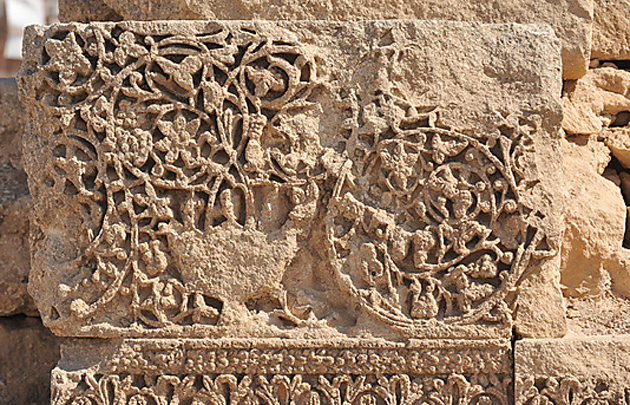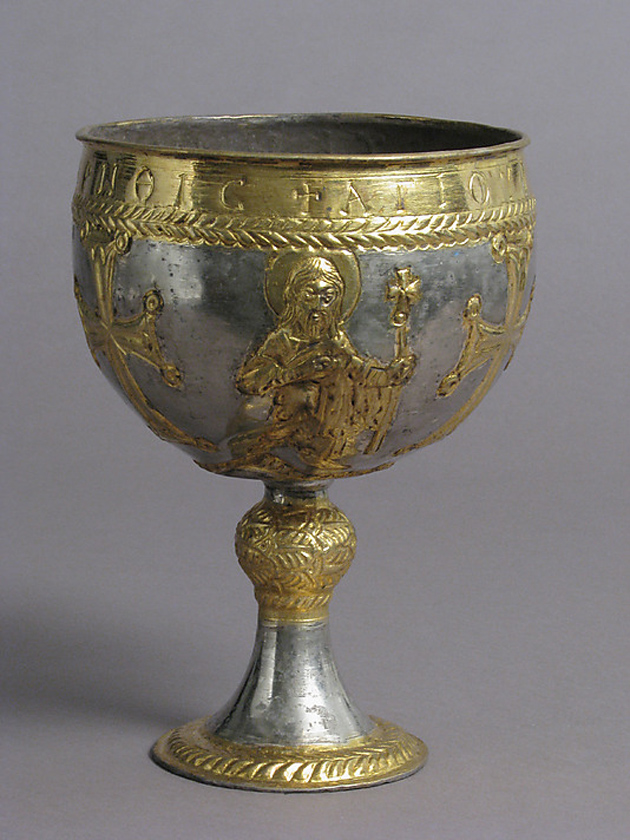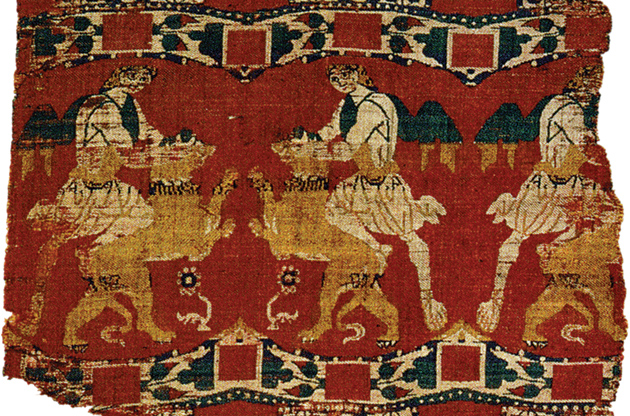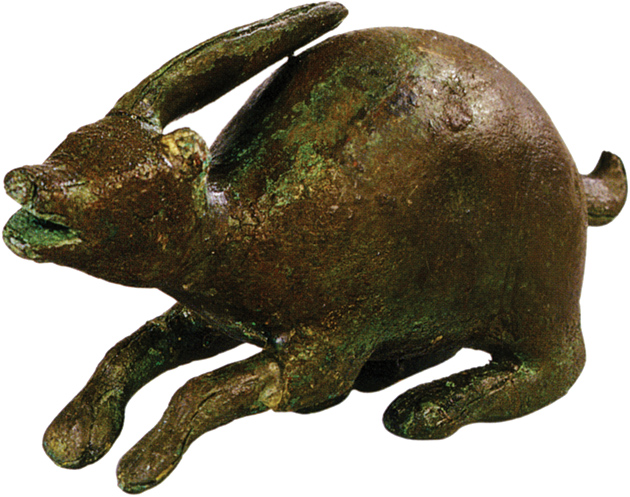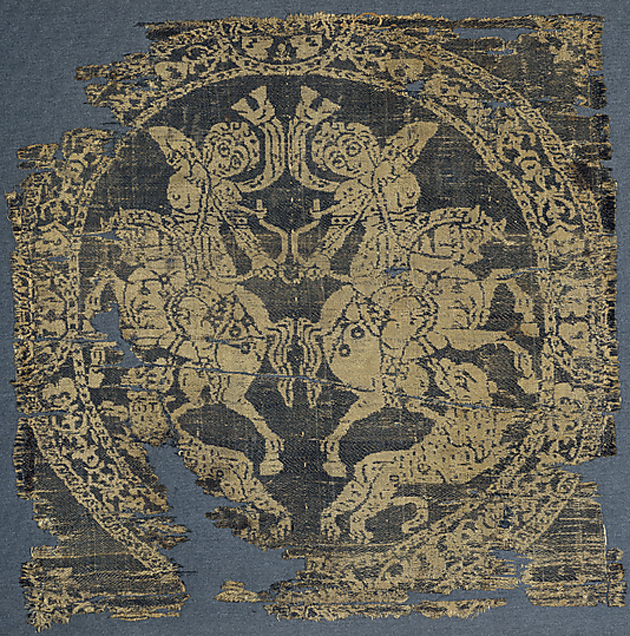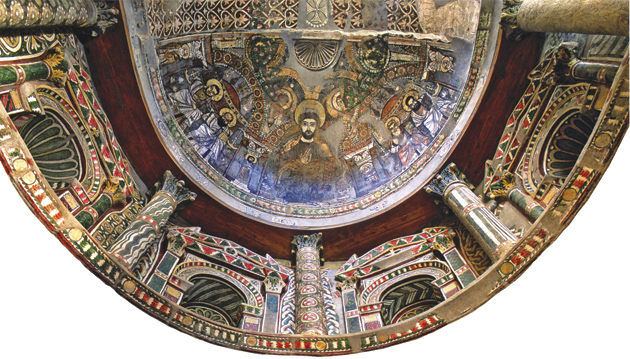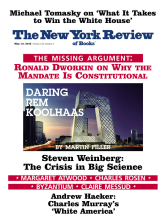In the century between 630 and 730 a considerable portion of the Old World took on its modern face. Through a series of astonishing campaigns, Arab Muslim armies created a single empire that, for a time, would reach from southern Spain to northern India and the western borders of China. From the “big bang” of these conquests a new galaxy emerged. From then onward, a closely interconnected chain of Muslim regions (one part of which, from modern Morocco to the borders of Iran, came to speak Arabic) stretched across Africa and Eurasia, joining the Atlantic to western China. A new civilization came into being, one that has lasted, with many permutations, into our own days. In the words of Finbarr Flood, a major contributor to the catalog of the Metropolitan Museum’s somewhat modestly titled exhibition “Byzantium and Islam: Age of Transition (7th–9th Century),” the foundation of the Arab empire was “one of the most remarkable achievements in human history.”
The exhibition takes us to the heart of this great detonation. It embraces the last century of the pre-Islamic Middle East and the first two centuries of Islam. To our surprise, we do not find ourselves in a world swept by a mighty wind. Instead, we enter a series of quiet rooms where time seems to stand still. Like a perfect late fall day, only the occasional rustle of a falling leaf startles us into realizing that the seasons are about to change. The few clear signs that Islam had, indeed, become politically dominant in the Middle East by the end of the seventh century strike us with almost ominous intensity. For there are so few of them.
In the room dedicated to commerce, we suddenly find silver coins that are like all their predecessors, except that they now bear a new religious message in a new, Arabic script. In the room before it, we notice the discreet censoring of the representation of a living creature on the floor of a Christian church, out of respect for Muslim attitudes toward art. In the last room, we come on pages of the Koran that look as ornate and magnificent as any Christian gospels of their time. They are covered with a Kufic script, whose bold, foursquare lines have an ancient grandeur, strangely unlike the fluid scripts that we now associate with medieval and modern Arabic.
In all these cases, we are brought up short by hints of purposive change in a world that, to all appearances, had not changed. Even with Islam present in it, we are looking back into a world before our own, still caught in the grip of antiquity, with its back still turned on the grand future of Islam in medieval and modern times. In retrospect, the first centuries of Islamic rule associated with the Umayyad dynasty (661–750) seem much closer to the ancient world and more open to non-Islamic influences than was the Islamic civilization that would emerge in later centuries.
This exhibition—along with the groundbreaking scholarship that has gone into its catalog—has banished the melodramatic tone with which the rise of Islam has usually been presented in standard accounts of the period. We can now say with confidence that the Arab armies did not leave a trail of desolation across the Middle East. Local populations did not sink into poverty. Far from retreating into the status of timorous minorities, vigorous Christian and Jewish communities continued to maintain their own traditions largely unmolested.
Most surprising of all, we can now suggest that the spread of Islam did not happen overnight. It was not imposed by force on the conquered peoples. Although their position as the rulers of a successful empire doubtless weighed heavily in their favor, Muslims talked their way into the Middle East quite as much as they fought their way across it. The words of Anna Ballian, author of one of the catalog essays, describing the relations between the Caliph Hisham (724–743) and the Christians at the great shrine of Saint Sergios at Rusafa in Syria, catch this strange mixture of curiosity and assertiveness. A Muslim such as Hisham (like many less powerful believers) could think of himself as
an undisputed ruler but by no means a foreign interloper, imposing himself by force…rather [as] a fellow traveler who shares the same heritage.
Muslims were not always welcome as fellow travelers. They could be pushy and proud. But they did not stifle debate. Their enterprise in what has been called “competitive self-definition” ensured that they remained in constant dialogue with those around them. As a result, Islamic civilization in its first centuries owed much of its richness to continued religious conversations among Muslims, Jews, and Christians. These conversations slowly changed the religious texture of the Middle East to the advantage of Islam. But until the year 1000, at least, it was the Muslims, and not the Jews and Christians, who were the minority religion. What we are looking at is not the Islam of the modern imagination. It is a very new Islam that was still trying to find a place for itself in a very old world.
Advertisement
Altogether, the Met exhibition offers the thrill of looking at the very first stages of a new world in the making. This new world did not emerge as a result of dramatic ruptures. Rather, it occurred, silently and all the more irrevocably, like a genetic mutation, through the accumulation of small changes in an ancient continuum.
To make one’s way through the exhibition, the catalog—edited by Helen Evans with the assistance of Brandie Ratliff—is more than usually helpful. There are two reasons for this—one bad and one very good.
Let us take the bad reason first. Loans of objects from Russia and Egypt that had been promised to the exhibition were canceled. But these objects are carefully described and commented upon in the catalog. This goes a long way to redress whatever imbalances their absence has created in the overall flow of a magnificently conceived exhibition. I would recommend particularly that readers linger over the discussion of the early Christian icons and of the Christian Arabic manuscripts preserved in the monastery of Saint Catherine in Sinai. For here we can listen to a Christianity of the Middle East that resolutely combined engagement with the Islamic present and loyalty to its own past. They show that Christianity found its own voice in the Arabic language, so as to contribute to the exuberant new Arabic culture. At the same time, Christians were still bound by their past. They continued to wrestle as they had for centuries under the Byzantine Empire—through the poignant art of icons quite as much as through formal writings—with the mighty paradox of a joining of God and man, a theme to which Jews and Muslims remained pointedly indifferent.
But the good reason could not be better. This catalog is an outstanding introduction to the transition from late antiquity to Islam. It presents the views of a new generation of scholars, who have brought significant changes of perspective to our understanding of the period as a whole. Their alert scholarship ranges widely. We have masterly essays by Finbarr Flood, on what was truly new about the art of the early Islamic world and on the production of the first Korans. We can also appreciate the novel application of radiocarbon datings (by Gudrun Bühl, Cäcilia Fluck, and others) to textiles and ivories. These redatings, made while assembling the exhibition, show, for instance, that in Egypt a classical tradition of ivory carving continued to flourish for centuries after the Arab conquest—witness the extraordinary set of ivories associated with the “Grado Chair,” which are usually tucked away in the far reaches of the Castello Sforzesco of Milan. Such expert discoveries prove that the populations of the Middle East, Christian and Jewish quite as much as Muslim, moved to rhythms that Western historians (hypnotized by the notion of the rise of Islam as marking a radical break in the history of the region) had not dreamed of until recently.
With the catalog in hand, let us visit this world. First, it is a world whose center of gravity shifted significantly toward the south. In the year 600, thirty-two years before the death of Muhammad, Mesopotamia, Syria, Egypt, and the fringes of Arabia were ruled from a considerable distance by the two great empires of the time—Byzantium and Sasanian Iran. They had languages of their own—especially Syriac and Coptic (the last version of the language of the Pharaohs). Greek was still widespread in the southern provinces of Byzantium. It could still delight (or afflict) students in unexpected places. For instance, around 600 AD, a young monk attempted to learn Greek by copying out onto a potsherd a series of maxims derived from the Greek comic writer Menander. He did this in the monastery of Epiphanios, which looked out over the ruins of ancient Luxor.
The economic heart of this region lay in Mesopotamia, to the east, and in the vast territory of Egypt, to the south. Beyond Egypt lay a yet deeper south. At the southern end of the Red Sea, Axum and what would become the Christian empire of Ethiopia faced the miraculous green of Yemen, an ancient south Arabian civilization where Christian and Jewish kingdoms fought to gain the upper hand throughout the sixth century. When the Arabs of the time of Muhammad spoke with admiration of a “great church,” it was not the far distant Hagia Sophia of Constantinople. It was the Great Church of Sana’a, built by an Ethiopian governor, with its golden mosaics covered with jewel-like images of trees.
Advertisement
For the inhabitants of these southern lands, the Arab conquests were not an explosion. They were an implosion. The two great empires collapsed at a touch, leaving the Middle East as a single zone, no longer divided by the military frontier between Byzantium and Sasanian Iran. For the first time since the days of Xerxes and Alexander the Great, it was possible to travel directly, within a single empire, from Alexandria to the foot of the Zagros Mountains in Iran and beyond. We can see this happen in the mosaics and products provided to the exhibition from Jordan. Regions that had lain on the dead end of a frontier now became thoroughfares. Synagogues and churches adjusted rapidly to the development of what Steven Fine calls a “new umbrella civilization.” The pottery kilns of Jerash in present-day Jordan (ancient Gerasa—a city already three millennia old by this time) briskly turned out new lamps, with a Christian inscription on one side and an Arabic, Muslim invocation on the other.
Up to the eighth century, mosaics continued to be placed in churches that contained images of the ancient cities of their region. Each city was shown, in a classical Roman manner, with colonnades, elaborate roofscapes, and ancient triumphal gates. Each was distinguished by its best-known monuments. Like images of the skyscrapers of New York, these little vignettes summed up an ideal of what a city should be. They reassured those who stepped on them that life had not changed.
But life had changed. After the Arab conquest, the cities of Jordan continued to thrive from new commerce. But they came to be flanked by very different buildings, in the midst of intensely irrigated estates, which were placed at a little distance from the cities. These were the new palaces of the Muslim Umayyad dynasty. Some of them, such as Mshatta (now on the edge of Amman airport), were as large as a small town. They are brought to life in the catalog by careful essays and by superb aerial photographs. Stone medallions taken from the exuberant façade of Mshatta strike us as we enter the last room of the exhibition. Eroded though they are, their warm stone is brilliantly lit, so as to highlight stylized leaves and grape-filled branches that have the tension of coiled springs. They suggest an energy that could go on forever, like the intricate permutations of moving patterns in a computer screen-saver. Palaces such as Mshatta reminded their owners and those who visited them of the vast cultural horizons and access to diverse skills that had opened up as a result of the implosion of the Middle East.
For those who frequented such palaces, as courtiers and bureaucrats, running the new empire was a matter of business as usual. Ancient empires had always depended on the collaboration of local elites, who knew their own region and how to work its complex fiscal systems so as to generate wealth for their rulers. The situation favored the “little big men”—the urban notables, the lesser nobility, and the gentry of the provinces. We already meet them as we enter the second room. Here we are faced with a spectacular array of silver-gilt chalices. These chalices were given by local families to the church of Attarouthi in Syria. To read the Greek inscriptions around their rims, which ask for the salvation and safety of their donors, is to read a gazetteer of the gentry.
Such people did not vanish with the coming of Islam. Take the case of John of Damascus (who died in 749). He is known as the great exponent of Greek Orthodoxy. But, although he wrote in Greek, he was an Arab Christian. His first name had been Mansur. His grandfather had handled the taxes of Damascus under the Byzantine emperor Heraclius. His father had served the first Muslim caliphs. He himself had retired to a life of contemplation and industrious polemics only after he had served as a bureaucrat. Far behind the rolling storm of the Muslim armies, local families such as that of John of Damascus settled down to assume the strain of administering the last and greatest empire of the ancient world.
Egypt was the province where the little big man throve. Ever since Roman times, it had been the workhorse of empire. The result was the creation of a particularly tenacious class of administrator-landowners. As late as the ninth century, the Sunni Muslim Caliph Ma’mun (813–833) was entertained in Egypt by a wealthy Coptic widow. She plied him with purses of gold presented on trays covered with rich brocade. These, she said, were the fruits of wealth “obtained from this soil and your justice! We have a great deal of it.”
It is time to look more closely at the ideals of these people. We can do this through the unique collections of ivories and textiles that are the pride of the exhibition. For it is through ivories and, above all, through textiles that we get to the heart of the self-understanding of the persons (Muslims, Jews, and Christians alike) who both bore the burdens of empire and reaped its profits. What did these objects mean to them? For textiles, the answer is plain. Textiles meant robes, and robes meant status. Looking at the spectacular Coptic textiles in the exhibition we are looking at a language of wealth and power that runs from one end of the period to the other. Many of these robes have been redated to the seventh and eighth centuries. Muslims would have worn them with as much pride as did Jews and Christians.
These robes swathed their bearers in a mystique of good fortune. This mystique was adopted by members of every religious group. The ninth- or tenth-century shawl of Apa Toter carried an inscription that combined Kufic and Coptic letters that wished: “use it in happiness…and rejoice.” A contemporary shawl bore an inscription in Arabic that wished the Muslim wearer “blessing and happiness and safety.”
It is against the background refrain of the search for happiness and abundance that we must place the art of Christians, Jews, and Muslims throughout this period. The notion of abundance gave meaning to the echoes of classical themes that ran through the textiles from the sixth to the tenth century. We sometimes fail to notice how serious and how persistent this theme was. We treat the gods and goddesses, and the heroes and heroines of Greek mythology that appear on Coptic textiles, as if they were folkloristic fragments whose origin and purpose had long been forgotten. We tend to smile when confronted, in the first room, by a great Coptic hanging where little cherubs that look as if they were made in Lego offer baskets of heaped fruits at the end of spindly arms.
But the hint of abundance that is conjured up by this gesture was no trivial matter. For the cherubs personified the wealth of the soil from which the fortunes of the little big men of Egypt grew. The gods may have died. But the warm energies that the gods represented still breathed through the robes and tapestries that sheathed the great and rendered their houses magnificent.
We forget this because we have been taught to see late antiquity and early Islam in exclusively religious terms. In the words of Finbarr Flood, the period has suffered from an “excessive focus on religiosity.” Anna Ballian warns us not to assume that “religion permeated every aspect of medieval society and in importance far outweighed secular matters.” For this was by no means the case. There was always room for a “religion of the world”—a tenacious conviction that there was more to life than piety. There was also something thrilling and almost numinous about wealth, good health, and the gift of children.
Hence the tenacity of themes taken from classical mythology. The curling vine of Dionysos spreads through every monument, textile, and ivory of the period. Plump Silenus appears on the exquisite late-classical silverware of Constantinople. But we also find him reeling among naughty maenads on the tapestries of Egypt. Most surprising of all, we find him on a brazier found in the Islamic palace of al-Fudayn (Mafraq, Jordan), still flanked by distinctly playful persons in the nude. Amazons on jaunty horses continue from the fourth to the ninth century—by which time they carry the Arabic bismillah (“In the Name of God”) woven beside them.
But perhaps the longest-lasting motif is the hare, an ancient symbol of fertility. It is constantly reproduced on textiles. The hare also entered the repertoire of Islamic ceramics and glasswork. And so (in the next-to-last room) we see a late, late classical bunny making its positively last appearance, its great ears transformed almost beyond recognition into a geometrical pattern, in a ninth-to-tenth-century lusterware bowl from Iraq or Egypt.
Many of these spectacular textiles came from the outskirts of Akhmim in Middle Egypt. Akhmim had once been called Panopolis, the City of Pan. In the fourth and fifth centuries, Panopolis had been a racy place. It had produced Greek poets who made it to the top of Byzantine society. From his great monastery, only twenty miles away across the river, the monastic leader Shenoute of Atripe (died circa 465)—whom we meet at the far end of room two—fulminated against the flashy gentry of Panopolis, most of whom were Christians, as no better than “Hellenes”—that is, pagans. Yet the textiles excavated from the necropolis of Akhmim show that they took little notice of the fierce abbot. For the next half-millennium the little big men of Panopolis (Christian, Jewish, and Muslim) continued to thrive. As Copts they called their city Schmin. As Muslims, they called it Akhmim. But the textiles continued to arrive. By the end of the period they came to Egypt from regions joined by the great galaxy of Islam—from as far apart as Central Asia and Tunis.
Faced by the changes associated with the rise of Christianity in late antiquity, it was once fashionable to cite, with approval, the lines of Swinburne:
Thou hast conquered, O pale Galilaean; the world has grown grey from thy breath….
For the little big men of Panopolis/Akhmim (and for many like them elsewhere)—Jews, Christians, and Muslims—the world had by no means turned gray. It was as bright as ever.
If we turn back to the remarkable work of Elizabeth Bolman on the newly restored frescoes of the church of the Red Monastery, near Sohag in Middle Egypt, we see that gloom did not prevail even in the great monastery of Shenoute. The frescoes date from the seventh century—from the very moment that the world appeared to have been turned upside down by the Arab conquests. Their message was far from gray. The faces of patriarchs and of holy men with deep-set, piercing eyes forcibly asserted the unbroken chain of masters and disciples on which the Christian tradition of the monastery rested. This sense of continuity ensured that, in succeeding centuries, the great monasteries of Egypt emerged as the flagships of Christian culture.
We forget how impressive these monasteries were. In the early Middle Ages, they towered above the better-known libraries and monastic foundations of the West. In the year 900, the library of the White Monastery of Shenoute housed at least a thousand manuscripts. This was twice as many as any library in Charlemagne’s Europe. Still protected and endowed by the local Christian gentry, they were spectacular places. The bright patterns of ornamental painting covered the walls of the Red Monastery like a splendid, rustling tapestry.
In around the year 600, these developments still lay in the future. But the young monk from the monastery of Epiphanius at Luxor, who copied out the Greek maxims of Menander, chose one maxim that says it all: “We all wish to get rich. But not all of us make it.”
The exhibition is, frankly, about those who made it. The mosaics, the silverware, the parchment volumes, the ivories, and the textiles (even the poignant little shirts of those who died young) once gave confidence and joy to those who could afford them. This is an exhibition not only about what people worshiped, but also about what they loved and what they hoped for. Landowners, administrators, and clergymen, they were not necessarily saints, heroes, or heroines. But their mute remains take us back to centuries whose final outcome they themselves could not have imagined. They form a human—and, let us hope, a humane—link between our own times and a distant, major turning point in the history of the world.


